Table of Contents
Introduction
Smart Sensors Statistics: The rise of intelligent sensors marks a significant leap forward in numerous fields, fundamentally transforming how we acquire and engage with environmental information.
These highly advanced sensors, incorporating state-of-the-art technology, have become essential in various industries, including manufacturing, healthcare, agriculture, and urban development.
Moreover, smart sensors empower us to collect real-time data, furnishing invaluable knowledge that fuels well-informed choices and bolsters operational effectiveness.
Further, their integration continues to expand, these sensors assume a progressively crucial role in overseeing systems. Optimizing the allocation of resources, and ultimately shaping the trajectory of technology and industry.
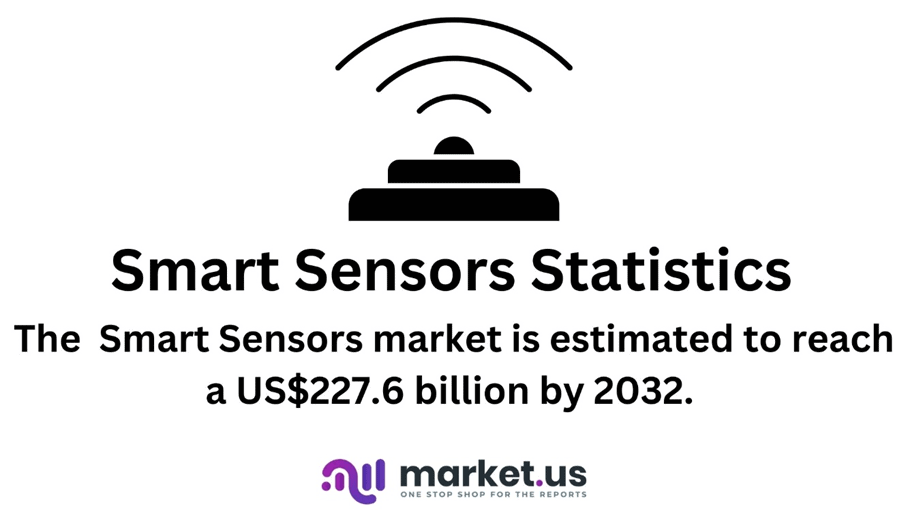
Editor’s Choice
- In 2022, the Smart Sensors market revenue stood at 45.7 billion.
- In 2032, the market is forecasted to reach a substantial size of 227.6 billion.
- Among men, 25% utilize these wearable devices, while among women, the adoption rate stands at 17%.
- In the age bracket of 18-49, 25% of individuals use these wearable devices.
- Notably, the adoption rate is significantly higher among individuals with an income of $75,000 or more, at 31%.
- Smart sensors are essential components for the utilization of A.I. technology. For example, they are utilized in the field of smart manufacturing. The estimation of the market size is expected to grow to 17.4 billion Yuan by 2022.
- However, the distributed Fibre Optic Sensors market generated revenue of approximately USD 156 million.
- The sales revenue for Magnetic Field Sensors exhibited a consistent upward trend over seven years, from 2015 to 2021.
- Automotive Sensor Sales Global Forecast 2021 Automotive sensor sales worldwide will be around 9.7 billion in 2021.
Smart Sensors Market Size
- In 2022, the Smart Sensors market size stood at 45.7 billion. Over the following years, there was a consistent upward trend in market growth.
- In 2023, it increased significantly to 53.9 billion, and this growth trajectory continued into 2024 when the market expanded further to 62.3 billion.
- As we moved into 2025, the market experienced substantial growth, reaching 76.4 billion, signifying a robust upward momentum.
- The trend continued in 2026, with the market size increasing to 91.8 billion, and by 2027, it reached 106.1 billion, underlining a steady pattern of expansion.
- As we look ahead to 2028, the market is projected to grow to 117.8 billion, and this growth trend persists into 2029, with a market size of 138.9 billion.
- Moreover, In 2030, the market is expected to expand further to 160.5 billion, indicating sustained growth. In 2031, the upward trajectory continues, with the market size projected to rise to 189.3 billion.
- Finally, in 2032, the market is forecasted to reach a substantial size of 227.6 billion. Highlighting the consistent and significant growth observed over the analyzed period.
(Source – Market.us)
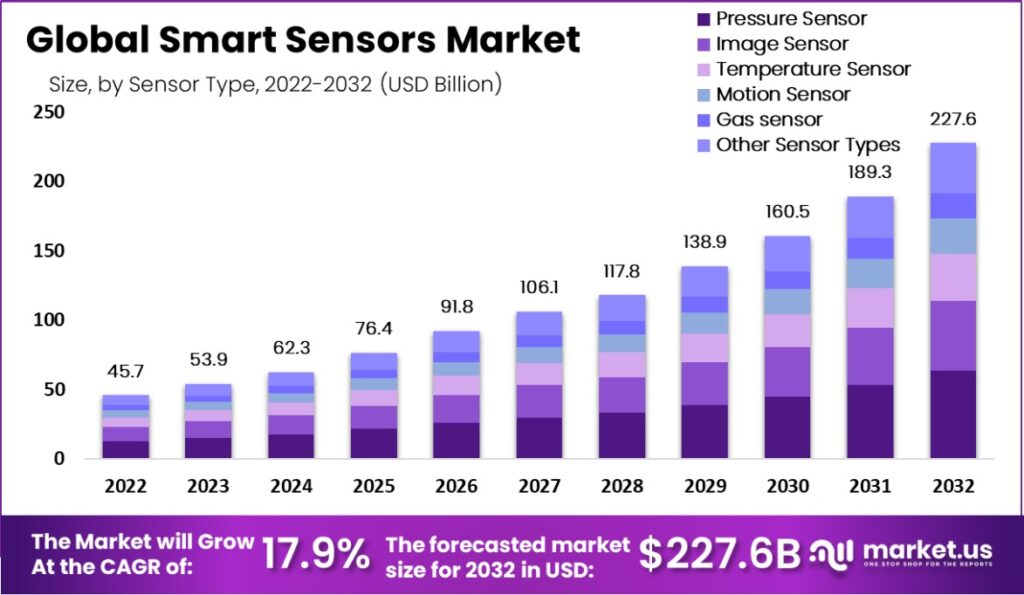
User Demographics of Smart Sensors Statistics
Smart Sensors Statistics By Gender
- The provided data represents the usage of smartwatches and fitness trackers among different genders.
- Among men, 25% utilize these wearable devices, while among women, the adoption rate stands at 17%.
- This discrepancy in usage rates underscores variations in technology preferences and lifestyle choices among different gender groups.
- Further, understanding these distinctions is essential for manufacturers and marketers, enabling them to tailor their products and marketing strategies to effectively reach and engage with their target audiences, male or female, in the ever-expanding wearable technology market.
(Source – Pew Research)
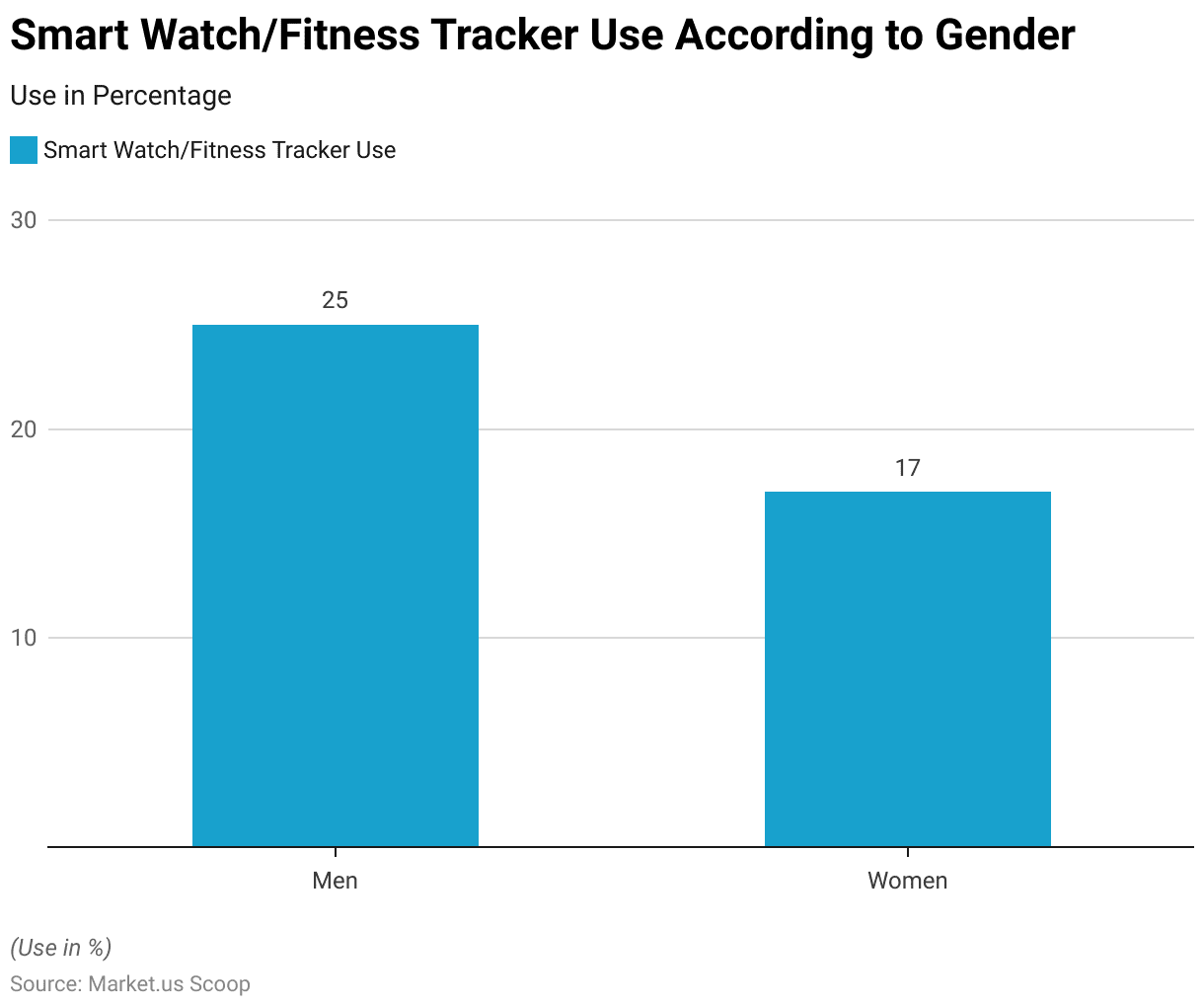
Smart Sensors Statistics By Age
- The provided data illustrates the utilization of smartwatches and fitness trackers among different age groups.
- In the age bracket of 18-49, 25% of individuals use these wearable devices substantially. Meanwhile, among those aged 50 and above, the adoption rate is slightly lower, at 18%. Further, these statistics highlight the varying degrees of acceptance and incorporation of wearable technology into daily routines across different age demographics.
- Moreover, recognizing these distinctions is pivotal for manufacturers and marketers to target and cater effectively to the preferences and needs of diverse age groups within the expanding wearable tech market.
(Source – Pew Research)

Smart Sensors Statistics By Education
- The provided data reveals the utilization of smartwatches and fitness trackers among individuals categorized by their educational backgrounds.
- Among those with a high school education or less, 15% are reported to use these wearable devices. In contrast, individuals with some college education exhibit a higher adoption rate, with 25% using smartwatches and fitness trackers.
- Among those with a college education or higher, the usage rate is 27%.
- These statistics shed light on the correlation between educational attainment and the adoption of wearable technology.
- Understanding these distinctions is valuable for educators, technology manufacturers, and marketers alike, as it helps tailor educational strategies and product development to cater to different population segments based on their educational backgrounds and tech preferences.
(Source – Pew Research)
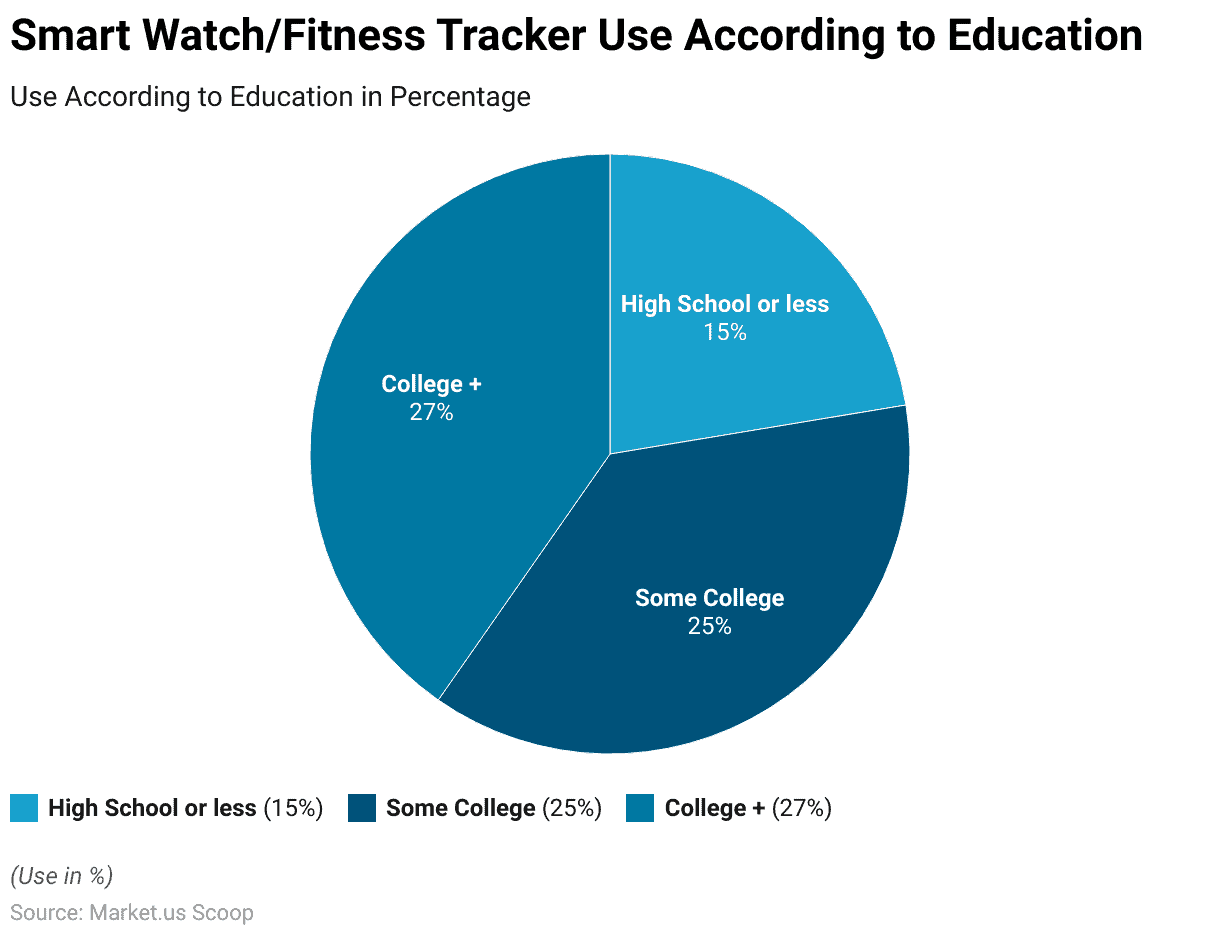
Smart Sensors Statistics By Income
- The provided data offers insights into adopting smartwatches and fitness trackers based on individuals’ income levels.
- Among those with an annual income of less than $30,000, 12% utilize these wearable devices.
- In the income bracket of $30,000 to $74,999, a higher percentage, specifically 20%, are reported to use smartwatches and fitness trackers.
- Notably, the adoption rate is significantly higher among individuals with an income of $75,000 or more, at 31%.
- These statistics underscore a clear correlation between income and the usage of wearable technology. Understanding these trends is crucial for manufacturers and marketers, as it helps them tailor their products and marketing strategies to cater to different income groups within the market, considering their varying preferences and needs.
(Source – Pew Research)
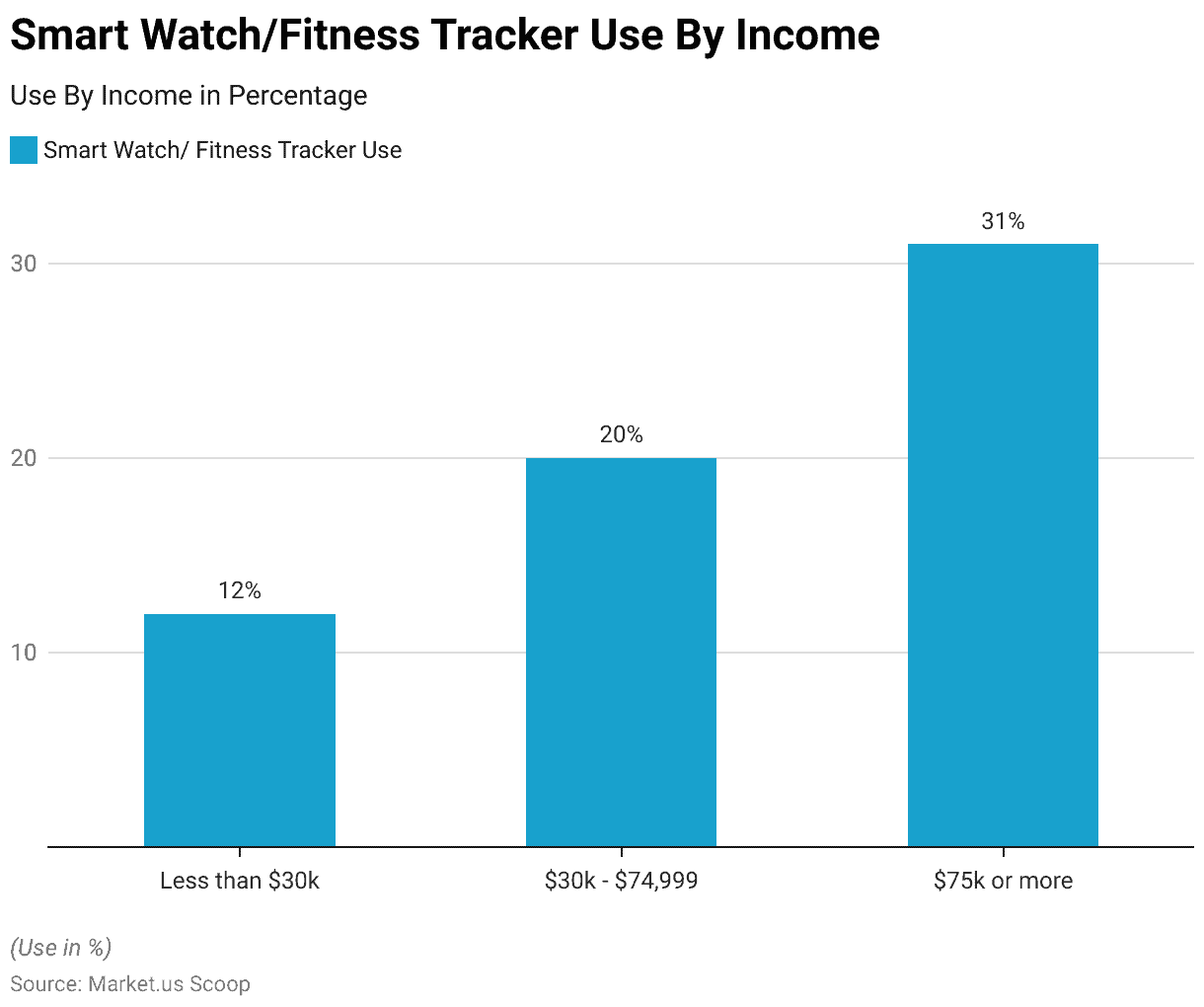
Smart Sensors Statistics By Residential Area
- The data provided presents the adoption of smartwatches and fitness trackers categorized by individuals’ residential areas.
- Among urban residents, 20% are reported to use these wearable devices, indicating a notable presence of technology enthusiasts in densely populated urban environments.
- In suburban areas, the adoption rate is slightly higher, standing at 24%, suggesting a somewhat greater interest in smartwatches and fitness trackers among those living in suburban settings.
- While still showing an 18% usage rate, rural areas exhibit a slightly lower adoption rate compared to urban and suburban regions.
- However, these statistics highlight the influence of residential location on the adoption of wearable technology and can be valuable for businesses and marketers aiming to tailor their products and marketing strategies to target different residential segments within the market effectively.
(Source – Pew Research)
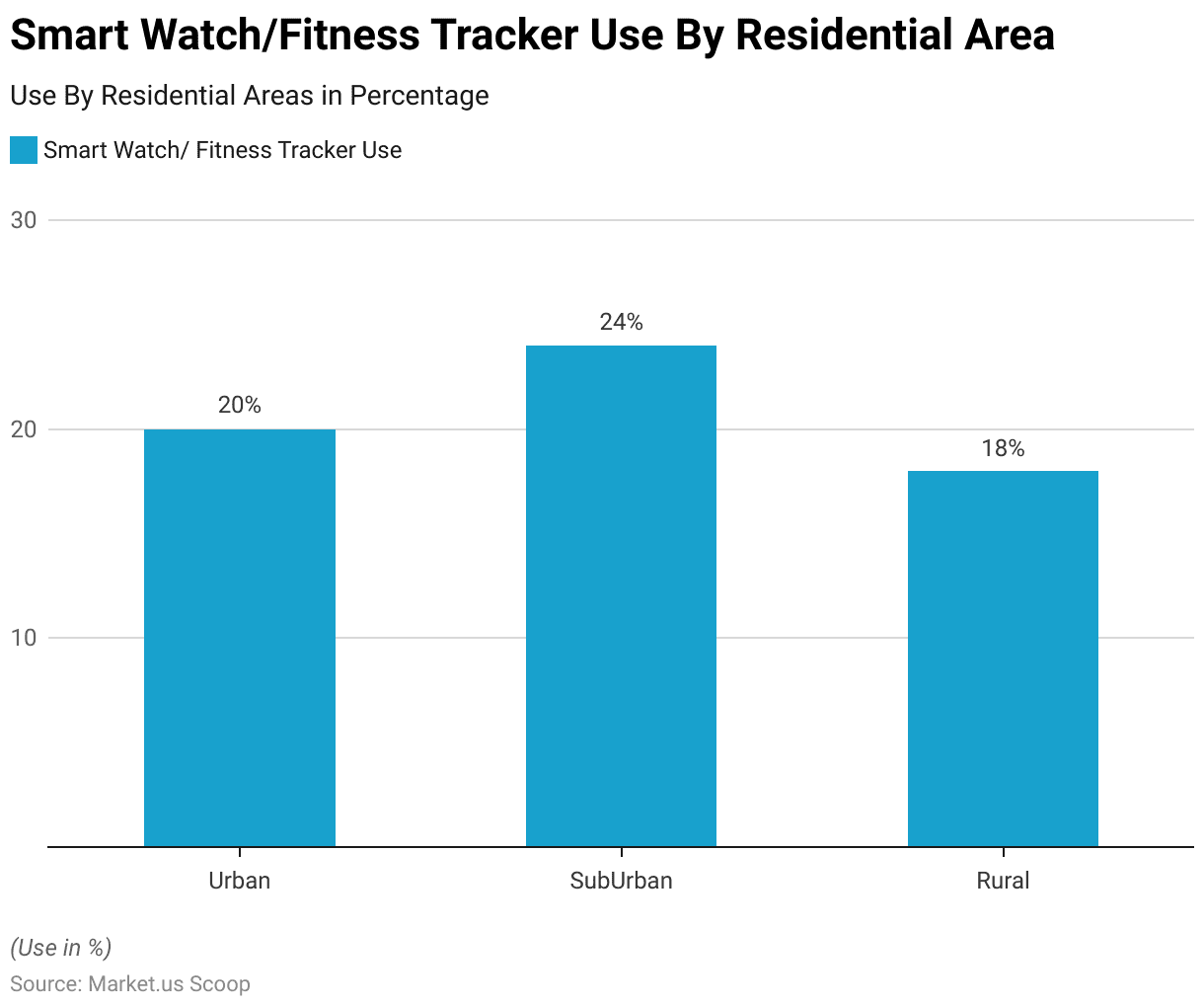
Types Of Smart Sensors
Automotive Sensors
- Automotive sensor market sales worldwide will be around 9.7 billion in 2021.
- The automotive sensor market size is estimated to grow from 2017 to 2021 at a CAGR of 25.6 billion U.S. dollars.
- The automotive MEMS market is estimated to be 4.5 billion U.S. dollars by 2021.
- OEMs will account for nearly 40 percent of the global market for intelligent automotive tires and sensors in 2024.
- The market size was estimated at 47 billion U.S. dollars in 2018 and is projected to grow at a CAGR of 6.7% to reach 77.5 billion U.S. dollars by 2024.
- While magnetic sensors are already widely used in modern cars, their use is only expected to grow.
- Autonomous vehicles are expected to contribute significantly to this market growth, as self-driving vehicles necessitate high-performance, precise magnetic sensors. Worldwide, the market size is expected to reach US$ 2.3 billion by 2030.
(Source – Statista)
Fingertips Sensors
- The size of the fingerprint sensor market is projected to expand from 2022 to 2028. In particular, the market size for fingerprint sensors in 2022 was estimated to be approximately U.S.$6 billion.
- The market size is projected to reach US$13.7 billion by 2028.
- The global fingerprint sensor market size for 2016, with a forecast for 2023.
- The estimated market size for touch fingerprint sensors in 2023 is US$ 8.91 billion.
- Apple accounted for 60 percent of the fingerprint sensor market.
- In 2023, the market size of touch fingerprint sensors is projected to reach 8.91 billion U.S. dollars.
- The utilization of capacitive technology represented 96.5% of fingerprint sensor recognition solutions in smartphones.
- In 2017, fingerprint sensors comprised 55% of all smartphones shipped worldwide.
- Forty-five percent of smartphones shipped globally in 2016 had a fingerprint sensor.
- Apple dominated the fingerprint sensor market with a 60 percent market share in 2014.
(Source –Statista)
Pressure Sensor
- In 2016, the pressure sensor market was expected to be worth 7.5 billion U.S. dollars worldwide.
- In 2016, it was estimated that the piezorespiratory pressure sensor segment in Asia-Pacific would be valued at USD 226 million.
- The pressure sensor market in the Asia-Pacific region was estimated to be worth USD 2.5 billion in 2016.
- The automotive market for MEMS pressure sensors is estimated to be worth US$ 812 million in 2018.
(Source –Statista)
Magnetic Field
- The sales revenue for Magnetic Field Sensors exhibited a consistent upward trend over seven years, from 2015 to 2021.
- In 2015, the revenue started at $1.5 billion, the foundation for subsequent growth.
- The following year, in 2016, sales saw a notable increase, reaching $1.8 billion.
- This positive trajectory continued in 2017, with sales reaching $2 billion, demonstrating a steady demand for magnetic field sensors.
- In 2018, revenue continued its ascent, reaching $2.1 billion, and further increased to $2.3 billion in 2019, showcasing the market’s expanding interest in these sensors.
- The trend persisted in 2020, with sales reaching $2.4 billion, culminating in 2021 with a significant revenue milestone of $2.6 billion.
- This data illustrates the consistent growth and demand in the market for magnetic field sensors during these seven years.
(Source –Statista)
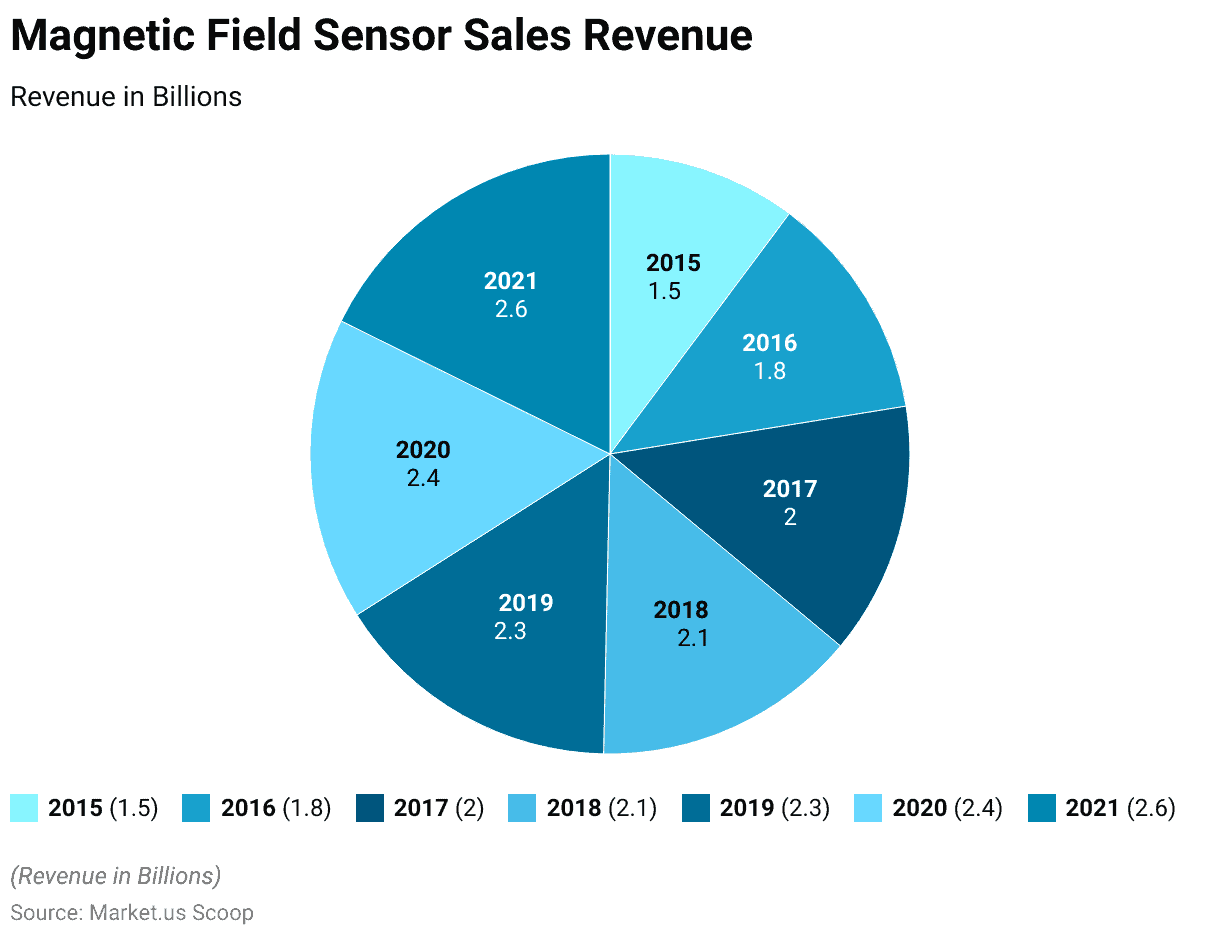
Fibre Optic
- The distributed Fibre Optic Sensors market generated revenue of approximately USD 156 million.
- Revenue by application In 2016, the Fibre Optic Sensors temperature sensing segment in the U.S. accounted for approximately $80 million in revenue.
(Source –Statista)
Sensors Market Regional Analysis
China
Smart sensors are essential components for the utilization of A.I. technology. For example, they are utilized in the field of smart manufacturing. It is estimated that the market size is expected to grow to 17.4 billion Yuan by 2022.
(Source –Statista)
Indonesia
In 2022, the Indonesian market for sensors and actuators generated revenue of more than 77 million U.S. dollars. It is expected that the market’s revenue will continue to grow steadily and reach approximately 113 million U.S. dollars by 2027.
(Source –Statista)
United States
The United States Sensors market accounted for approximately 156 million U.S. dollars in revenue in 2016.
(Source –Statista)
Recent Developments
Acquisitions and Mergers:
- Bosch acquires Proteus Digital Health: In mid-2023, Bosch completed its $300 million acquisition of Proteus Digital Health, a pioneer in smart sensor technologies for healthcare applications. This acquisition aims to integrate Proteus’s advanced sensor technology into Bosch’s healthcare and IoT offerings.
- Honeywell acquires Sine Group: Honeywell acquired Sine Group, a provider of visitor management and workplace solutions, for $125 million in late 2023. This merger is expected to enhance Honeywell’s smart building solutions by integrating Sine’s sensor technologies for better occupancy management and security.
New Product Launches:
- Texas Instruments Smart Temperature Sensors: In early 2024, Texas Instruments launched a new line of smart temperature sensors designed for industrial applications. These sensors offer high accuracy, low power consumption, and integrated signal processing, making them ideal for monitoring and controlling industrial processes.
- STMicroelectronics’ Environmental Sensor Suite: STMicroelectronics introduced an advanced environmental sensor suite in mid-2023, featuring sensors for temperature, humidity, air quality, and pressure. This suite is designed for use in smart home and building automation systems.
Funding:
- Sensirion secures $85 million: In 2023, Sensirion, a leading manufacturer of environmental and flow sensors, raised $85 million in a funding round to expand its production capabilities and accelerate the development of new sensor technologies.
- AMS AG raises $120 million: AMS AG, a sensor solutions company, secured $120 million in early 2024 to invest in R&D and expand its portfolio of optical and environmental sensors, aiming to enhance their applications in consumer electronics and automotive markets.
Technological Advancements:
- AI-Enhanced Sensor Data Processing: Advances in AI and machine learning are being integrated into smart sensors to enable real-time data processing, predictive analytics, and enhanced decision-making capabilities, improving their performance and utility across various applications.
- Miniaturization and Integration: The development of smaller, more integrated smart sensors is ongoing, enabling their use in compact and portable devices, as well as in complex systems like wearables, medical devices, and IoT applications.
Market Dynamics:
- Growth in Smart Sensor Market: The global smart sensor market is projected to grow at a CAGR of 15.2% from 2023 to 2028, driven by increasing demand for IoT devices, advancements in automotive safety, and the rise of smart home technologies.
- Rising Adoption in Healthcare: Smart sensors are seeing increased adoption in healthcare for applications such as patient monitoring, wearable health devices, and diagnostic tools, contributing to market growth and improved healthcare outcomes.
Regulatory and Strategic Developments:
- EU Medical Device Regulation (MDR): The European Union implemented the updated Medical Device Regulation in early 2024, which includes stricter requirements for smart sensors used in medical devices, ensuring their safety, efficacy, and reliability.
- US FDA Digital Health Guidelines: The US Food and Drug Administration (FDA) issued new guidelines in 2023 for digital health devices, including smart sensors, to streamline the approval process and ensure that these technologies meet high standards of quality and safety.
Research and Development:
- Advanced Biometric Sensors: R&D efforts are focusing on developing advanced biometric sensors for applications such as secure authentication, health monitoring, and human-machine interaction, enhancing their accuracy and reliability.
- Energy Harvesting Sensors: Researchers are exploring energy harvesting technologies for smart sensors to extend their operational life and reduce dependency on batteries, making them more sustainable and suitable for remote and long-term applications.
Conclusion
Smart Sensors Statistics – In conclusion, smart sensors have emerged as transformative components in modern technology and industry.
These sensors, designed to collect specific data types and perform precise functions, have found widespread application across various sectors, from healthcare and manufacturing to environmental monitoring and consumer electronics.
Further, their ability to provide real-time data and insights has revolutionized decision-making processes and enhanced operational efficiency.
As smart sensors evolve and find new applications, their significance in the Internet of Things (IoT), automation, and data-driven decision-making is undeniable.
The diverse types of smart sensors available cater to various needs, contributing to their ubiquity in our daily lives. Smart sensors will remain at the forefront of innovation, shaping the future of technology, industry, and our connected world.
FAQ’s
Smart sensors are devices with integrated technology, such as microprocessors or communication capabilities, enabling them to collect data, process information, and transmit it to other devices or systems.
Smart sensors play a crucial role in various industries by providing real-time data, enhancing automation, improving efficiency, and enabling data-driven decision-making.
Common types of smart sensors include temperature, pressure, motion, light, and gas sensors, among others.
Smart sensors detect changes in their environment through various physical or chemical properties, convert these changes into electrical signals, and then process or transmit the data for further analysis.
Smart sensors are used in diverse applications, including industrial automation, healthcare monitoring, environmental monitoring, consumer electronics, and smart cities, to name a few.
The IoT is a network of interconnected devices that share data and communicate with each other. Smart sensors are a crucial component of the IoT, as they provide the data that drives IoT applications and solutions.
Many smart sensors have wireless communication capabilities, allowing them to transmit data to other devices or central systems without physical connections.
Discuss your needs with our analyst
Please share your requirements with more details so our analyst can check if they can solve your problem(s)



